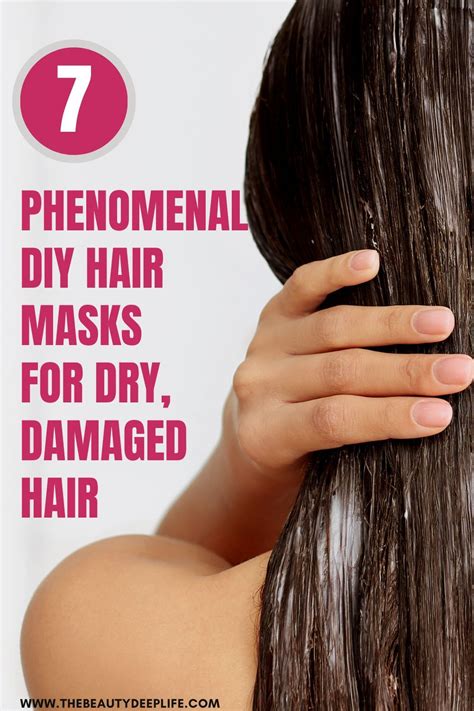Are you struggling with lifeless, brittle hair that seems beyond repair? Don’t despair just yet. A hair mask specifically designed for dead hair can work wonders in restoring its vitality and luster.

The Causes of Dead Hair
Dead hair is caused by various factors, including:
- Chemical treatments (dyeing, bleaching, perming)
- Excessive heat styling
- Sun exposure
- Pollution
- Chlorine exposure
Signs of Dead Hair
- Lack of shine
- Brittleness
- Split ends
- Rough texture
- Tendency to break easily
Benefits of a Hair Mask for Dead Hair
A hair mask tailored for dead hair offers numerous benefits:
- Moisturizes and nourishes dry, damaged strands
- Strengthens hair fibers, reducing breakage
- Repairs split ends
- Adds shine and smoothness
- Protects hair from further damage
When choosing a hair mask for dead hair, consider the following factors:
- Ingredients: Look for ingredients like keratin, argan oil, coconut oil, and shea butter. These are known for their hydrating, strengthening, and nourishing properties.
- Type: Masks come in different types, such as deep conditioners, repair masks, and leave-in treatments. Choose a mask that suits your hair’s needs and damage level.
- Frequency: Use a hair mask once or twice a week, depending on the severity of your hair damage.
If you prefer natural solutions, try these DIY hair mask recipes:
1. Avocado and Olive Oil Mask
- 1 ripe avocado
- 2 tablespoons olive oil
Mash the avocado and combine it with olive oil. Apply the mask to damp hair, leave it on for 30 minutes, and rinse thoroughly.
2. Coconut Oil and Yogurt Mask
- 1/2 cup coconut oil
- 1/4 cup plain yogurt
Heat the coconut oil slightly to make it liquid. Mix it with yogurt and apply it to damp hair. Leave it on for 20 minutes and rinse.
3. Banana and Honey Mask
- 1 ripe banana
- 2 tablespoons honey
Mash the banana and combine it with honey. Apply the mask to damp hair, leave it on for 15 minutes, and rinse.
Tips for Applying a Hair Mask:
- Wash your hair with a clarifying shampoo before applying the mask.
- Apply the mask generously from roots to tips.
- Cover your hair with a shower cap or plastic wrap to enhance absorption.
- Leave the mask on for the recommended time.
- Rinse the mask thoroughly with lukewarm water.
- Style your hair as usual.
If DIY remedies don’t meet your expectations, consider professional hair mask treatments such as:
- Olaplex
- Kérastase Fusio-Dose
- Davines Olaplex
These treatments typically use advanced formulas to penetrate deep into the hair shaft and repair damage from within.
Benefits of Professional Hair Masks
- High-potency ingredients
- Customized to your hair’s specific needs
- Visible results after one treatment
- Long-lasting effects
Considerations for Professional Hair Masks
- Cost: Professional hair masks can be more expensive than DIY options.
- Availability: Not all salons offer hair mask treatments.
- Time: Professional treatments usually take longer than DIY masks.
The choice between DIY and professional hair masks depends on your individual needs, budget, and hair damage level.
- DIY masks: Ideal for mild to moderate hair damage and those who prefer natural remedies.
- Professional masks: Recommended for severely damaged hair and those seeking dramatic results.
Table 1: Comparison of DIY and Professional Hair Masks
| Feature | DIY Masks | Professional Masks |
|---|---|---|
| Ingredients | Natural, limited | Advanced, potent |
| Cost | Affordable | More expensive |
| Results | Gradual | Instant |
| Time | Shorter | Longer |
| Suitability | Mild to moderate damage | Severe damage |
In addition to using hair masks, adopt the following practices to care for dead hair:
- Use a gentle shampoo and conditioner.
- Limit heat styling.
- Protect hair from heat with a heat protectant.
- Avoid chlorine exposure.
- Get regular trims to prevent split ends.
A hair mask specifically designed for dead hair can revitalize your locks, restore their health, and protect them from further damage. Whether you opt for DIY recipes or professional treatments, make hair masks a regular part of your haircare routine for stronger, shinier, and healthier hair.
